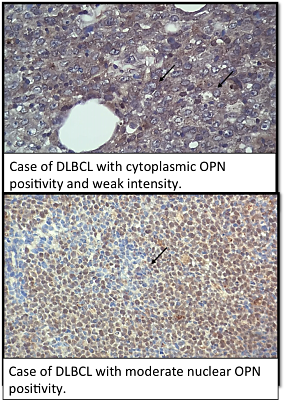
Contributions
Abstract: PB1738
Type: Publication Only
Background
Diffuse large B-cell lymphoma (DLBCL) is the most common type of lymphoma. It is a heterogeneous disease whose prognosis depends on the histological subtype (centralgerminal, non-centrogerminal), as well as other factors such as age, clinical stage, extranodal disease, ECOG scale and levels of lactate dehydrogenase (LDH) identified by established scales (IPI, NCCN-IPI). Osteopontin (OPN) a protein that is secreted by various cells and fulfills physiological functions, when produced by neoplastic cells favors tumor growth and metastasis. This has been corroborated in different types of cancer and there are few reports of cases of patients with DLBCL in which the tumor cell expresses osteopontin, characteristically these cases have presented an aggressive clinical behavior with extranodal disease.
Aims
To evaluate the expression of osteopontin in neoplastic lymphocytes and their association with overall survival; the percentage of patients who expressed osteopontin at diagnosis; the association between the expression of osteopontin and the histological subtype (germinal center, not centrogerminal, unclassifiable); the association between osteopontin expression and age, elevation of DHL, ECOG scale, clinical stage, extranodal invasion and the application of the IPI and NCCN-IPI scales.
Methods
Results
81 patients were evaluable. 43.2% of the cases were positive for OPN in neoplastic cells. The mean survival of patients with positive OPN was 14.8 months versus 16.5 months for patients with no OPN expression (p = 0.628). OPN positivity was not significantly associated with increased age, impaired functional status (ECOG 2,3,4), advanced clinical stage (III, IV), increased LDH or extranodal invasion (including central nervous system); neither was it associated with a specific histological subtype. Survival significantly decreased in patients with increased LDH (p=0.000137), ECOG 2,3,4 (p=1,7374E-7). Survival decreased significantly as the risk measured by the IPI and NCCN-IPI scales increased (p=0.000001, p=0.000013 respectively) with an average survival of 18.6 months for the low-risk group, compared with 6.4 months for the high-risk group.

Conclusion
Our findings demonstrate that approximately half of the cases evaluated express OPN at diagnosis and tend to have a lower survival rate, however, a longer follow-up time is needed, as well as other studies that discriminate between different isoforms or post-translational modifications of osteopontin to determine if this trend can reach significance. By demonstrating OPN expression by neoplastic cells we can devise new protocols that evaluate its usefulness as a surrogate marker of tumoral activity in DLBCL using non-invasive techniques (eg, quantification of serum levels), which would improve surveillance of these patients.
Session topic: 20. Aggressive Non-Hodgkin lymphoma - Clinical
Keyword(s): Osteopontin, Diffuse large B cell lymphoma
Abstract: PB1738
Type: Publication Only
Background
Diffuse large B-cell lymphoma (DLBCL) is the most common type of lymphoma. It is a heterogeneous disease whose prognosis depends on the histological subtype (centralgerminal, non-centrogerminal), as well as other factors such as age, clinical stage, extranodal disease, ECOG scale and levels of lactate dehydrogenase (LDH) identified by established scales (IPI, NCCN-IPI). Osteopontin (OPN) a protein that is secreted by various cells and fulfills physiological functions, when produced by neoplastic cells favors tumor growth and metastasis. This has been corroborated in different types of cancer and there are few reports of cases of patients with DLBCL in which the tumor cell expresses osteopontin, characteristically these cases have presented an aggressive clinical behavior with extranodal disease.
Aims
To evaluate the expression of osteopontin in neoplastic lymphocytes and their association with overall survival; the percentage of patients who expressed osteopontin at diagnosis; the association between the expression of osteopontin and the histological subtype (germinal center, not centrogerminal, unclassifiable); the association between osteopontin expression and age, elevation of DHL, ECOG scale, clinical stage, extranodal invasion and the application of the IPI and NCCN-IPI scales.
Methods
Results
81 patients were evaluable. 43.2% of the cases were positive for OPN in neoplastic cells. The mean survival of patients with positive OPN was 14.8 months versus 16.5 months for patients with no OPN expression (p = 0.628). OPN positivity was not significantly associated with increased age, impaired functional status (ECOG 2,3,4), advanced clinical stage (III, IV), increased LDH or extranodal invasion (including central nervous system); neither was it associated with a specific histological subtype. Survival significantly decreased in patients with increased LDH (p=0.000137), ECOG 2,3,4 (p=1,7374E-7). Survival decreased significantly as the risk measured by the IPI and NCCN-IPI scales increased (p=0.000001, p=0.000013 respectively) with an average survival of 18.6 months for the low-risk group, compared with 6.4 months for the high-risk group.

Conclusion
Our findings demonstrate that approximately half of the cases evaluated express OPN at diagnosis and tend to have a lower survival rate, however, a longer follow-up time is needed, as well as other studies that discriminate between different isoforms or post-translational modifications of osteopontin to determine if this trend can reach significance. By demonstrating OPN expression by neoplastic cells we can devise new protocols that evaluate its usefulness as a surrogate marker of tumoral activity in DLBCL using non-invasive techniques (eg, quantification of serum levels), which would improve surveillance of these patients.
Session topic: 20. Aggressive Non-Hodgkin lymphoma - Clinical
Keyword(s): Osteopontin, Diffuse large B cell lymphoma


